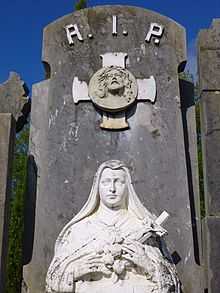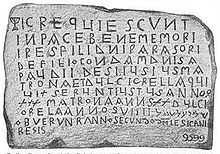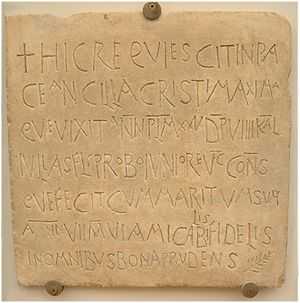Rest in peace
"Rest in peace" (Latin: Requiescat in pace) is a short epitaph or idiomatic expression wishing eternal rest and peace to someone who has died. The expression typically appears on headstones, often abbreviated as "RIP" or R.I.P.
Description
| Part of a series on |
| Christianity |
|---|
 |
|
|
|

The phrase dormit in pace (English: "he sleeps in peace") was found in the catacombs of the early Christians and indicated that "they died in the peace of the Church, that is, united in Christ."[1][2][3] The acronym R.I.P., meaning "rest in peace", continues to be engraved on the gravestones of Christians from several denominations,[4] especially the Catholic Church, the Lutheran Church and the Anglican Church.[5]
In burial services of the Catholic Church according to the Tridentine Rite, which includes the Missa pro Defunctis (Requiem Mass), the phrase appears several times.[6]
In modern ecclesiastical Latin, "requiēscat in pāce" is pronounced [rekwiˈeskat in ˈpatʃe], whereas in classical Latin it would be pronounced [rɛkʷiˈeːskat ɪn ˈpaːkɛ].
To satisfy a vogue for rhyming couplets on tombstones, the phrase has been parsed ungrammatically as:[7]
| “ | Requiesce cat in pace |
” |
A similar phrase in found in the book of Isaiah, 57:2:
| “ | ...will come in peace, and they will rest in their beds, he who goes straightforward. | ” |
This verse has been found inscribed in Hebrew on gravestones dating from the 1st century BC, in the graveyard of Bet Shearim. It speaks of the righteous person who died because he could not stand the evil surrounding him. A recapture of these words, read as "come and rest in peace," has been transferred to the ancient Talmudic prayers, in a mixture of Hebrew and Aramaic of the 3rd century AD. It is used to this day in traditional Jewish ceremonies.[8]
History

The phrase was not found on tombstones before the eighth century.[9][10] It became ubiquitous on the tombs of Christians in the 18th century,[5] and for High Church Anglicans, as well as Roman Catholics in particular, it was a prayerful request that their soul should find peace in the afterlife.[4] When the phrase became conventional, the absence of a reference to the soul led people to suppose that it was the physical body that was enjoined to lie peacefully in the grave.[11] This is associated with the Christian doctrine of the particular judgment; that is, that the soul is parted from the body upon death, but that the soul and body will be reunited on Judgment Day.[12]
Other variations include "Requiescat in pace et in amore" for "May she rest in peace and love", and “In pace requiescat et in amore”. The word order is variable because Latin syntactical relationships are indicated by the inflexional endings, not by word order. If “Rest in peace” is used in an imperative mood, it would be “Requiesce in pace” (acronym R.I.P.) in the second person singular, or “Requiescite in pace” in the second person plural.[13] In the common phrase "Requiescat in pace" the "-scat" ending is appropriate because this is a "hortatory subjunctive": "May he/she rest in peace."
In art
-

Excerpt from gravestone in Święciechowa, showing R.i.p.
-
This cross from 1720 bears the complete Latin phrase in its plural form ("Requiescant in pace")
-

This funerary tablet from 525 AD begins with the phrase
-

Requiescat, oil on canvas painting by Briton Rivière, 1888, Art Gallery of New South Wales.
Linguistic analogues
Phrases in other languages:
- Albanian: U prehtë në paqe (P.N.P.)
- Afrikaans: Rus in vrede
- Arabic: ارقد في سلام (Orqod fi salaam)
- Azerbaijani: Allah Rəhmət eləsin
- Basque: Goian Bego (G.B.)
- Bengali: চির নিদ্রায় শায়িত
- Bosnian: Počivaj u miru
- Belarusian: Спачывай у спакоі (Spačyvaj u spakoi)
- Bulgarian: Почивай в мир (Pochivaj v mir)
- Catalan: Descansi en pau (DEP)
- Chinese: 安息 (Mandarin: Ān xī, Cantonese: ngon1 sik1, Hakka: sit ôn)
- Czech: Odpočívej v pokoji
- Croatian: Počivao/počivala u miru.
- Church Slavonic / Slavic:
([ˈt͡sarsvije nʲɛˈbʲɛsnoje], “Kingdom of Heaven [for him/her]”)
- Danish: Hvil i fred
- Dutch: Rust in vrede
- Esperanto: Ripozu pace (R.P.)
- Estonian: Puhka rahus
- Faroese: Hvíl í friði
- Finnish: Lepää rauhassa
- French: Repose en paix (R.E.P.)
- German: Ruhe in Frieden
- Georgian: ცხონდეს, ღმერთმა აცხონოს (“May God grant him/her eternal life”)
- Greek: Αναπαύσου εν ειρήνη ([anaˈpafsu en iˈrini])
- Hebrew: תהא נשמתו צרורה בצרור החיים (Tehe nishmato tsrura bitsror hahayim) (תנצב"ה)
- Hindi: दिवंगत आत्मा को शांति (Hindi, India) {divangat Atma ko shanti}
- Hungarian: Nyugodjék békében
- Icelandic: Hvíli í friði (H.Í.F.)
- Indonesian: Beristirahat dengan Tenang (B.d.T.)
- Irish: Ar dheis Dé go raibh a (h)anam (Lit.On God's right may his/her soul be)
- Italian: Riposi in pace (R.I.P.)
- Japanese: 安らかに眠れ (Yasuraka ni nemure)
- Korean: 고인의 명복을 빕니다 (Goinui myeongbogeul bimnida)
- Kurdish: به ئارامی بمر یت
- Kyrgyz: Жаткан жери жайлуу болсун (Jatkan jeri jayluu bolsun)
- Lithuanian: Ilsėkis ramybėje
- Macedonian: Почивај во мир (Pochivaj vo mir)
- Mongolian: Гүн эмэгнэл элрхийлье (Gün emegnel elrkhiiliye)
- Nepali: दिवंगत आत्माको चिरशान्तिको कामाना
- Norwegian: Hvil i fred
- Persian: روحش شاد (Roohash shaad)
- Polish: Spoczywaj w pokoju,
- Portuguese: Descanse em Paz
- Romanian: Odihnească-se în pace
- Russian: Покойся с миром ([pɐˈkojsʲə sˈmʲirəm])
- Pre-reform: Покойся съ миромъ
- Scottish Gaelic: Gus am bris an là (lit. Until the day breaks)
- Serbian: Почивај у миру.(Počivaj u miru)
- Slovak: Odpočívaj v pokoji
- Slovene: Počivaj v miru
- Spanish: Descanse en paz/Que en paz descanse (D.E.P./Q.E.P.D.)
- Swedish: Vila i frid
- Tagalog: Sumalángit Nawâ (S.L.N., “In heaven may [he/she/they] be”)
- Tajik: ҷояш ҷаннад шавад (dʒojaʂ dʒanat ʂavad)
- Tamil: பிரிந்த ஆத்துமாவிற்கு சாந்தியை (Tamil, India) {Pirinta āttumāviṟku cāntiyai}
- Telugu: వెళ్ళిపోయాడు ఆత్మ శాంతి (Telugu, India) {Veḷḷipōyāḍu ātma śānti}
- Thai: ขอให้ไปสู่สุขคติ
- Turkish: Huzur içinde yat
- Uzbek: Joying jannatdan bolsin
- Ukrainian: Спочивай з миром
- Urdu: امن سے آرام
- Vietnamese: Hãy An Nghỉ
- Welsh: Gorffwys mewn hedd
See also
References
- ↑ Yaggy, Levi W.; Haines, Thomas Louis (1886). Museum of Antiquity: A Description of Ancient Life--the Employments, Amusements, Customs and Habits, the Cities, Places, Monuments and Tombs, the Literature and Fine Arts of 3,000 Years Ago. Law, King & Law. p. 885.
- ↑ Tuker, Mildred Anna Rosalie; Malleson, Hope (1900). "Introduction to the Catacombs". Handbook to Christian and Ecclesiastical Rome: The Christian monuments of Rome. A. and C. Black. p. 411.
Dormit, he sleeps, as an expression for death is proper to Christianity. Dormitio, in somno pacis, dormivit are therefore very frequently found. These and the expression Dormierit in Domino (may he sleep in the Lord) are to be seen especially in loculi of the II. and II. centuries, and occur in S. Agnese.
- ↑ Leahy, Brendan (2012). His Mass and Ours: Meditations on Living Eucharistically. New City Press. p. 53. ISBN 9781565484481.
Signs such as "RIP" (Rest in Peace) on the tombs of the early Christians didn't just mean they died "peacefully" but that they died in the peace of the Church, that is, united in Christ in the Church and not apart from it.
- ↑ 4.0 4.1 Mytum, H. C. (31 December 2003). "Christian Denominations". Mortuary Monuments and Burial Grounds of the Historic Period. Springer Science & Business Media. p. 139. ISBN 9780306480768.
- ↑ 5.0 5.1 Tarling, Nicholas (16 May 2014). Choral Masterpieces: Major and Minor. Rowman & Littlefield Publishers. p. 87. ISBN 9781442234536.
- ↑ Holy See (1961), Graduale Romanum, 1961 Edition by the Benedictines of the Solesmes Monastry, Desclée, p. 94*-112*
- ↑ Francis Edward Paget (1843), A tract upon tomb-stones, p. 18
- ↑ El male rachamim
- ↑ The Church of England magazine (Church Pastoral-aid Society), 1842: 208 Missing or empty
|title=(help) - ↑ Robert Jefferson Breckinridge, Andrew Boyd Cross, The Baltimore literary and religious magazine 3: 206 http://books.google.com/books?id=xtQRAAAAYAAJ&pg=PA206 Missing or empty
|title=(help);|chapter=ignored (help) - ↑ Joshua Scodel (1991), The English poetic epitaph, Cornell University Press, p. 269, ISBN 978-0-8014-2482-3
- ↑ Karl Siegfried Guthke (2003), Epitaph culture in the West, p. 336
- ↑ Expert: Maria - 7/31/2009 (2009-07-31). "Experts on Latin phrase". En.allexperts.com. Retrieved 2014-04-17.
| Wikimedia Commons has media related to Requiescat in pace. |
